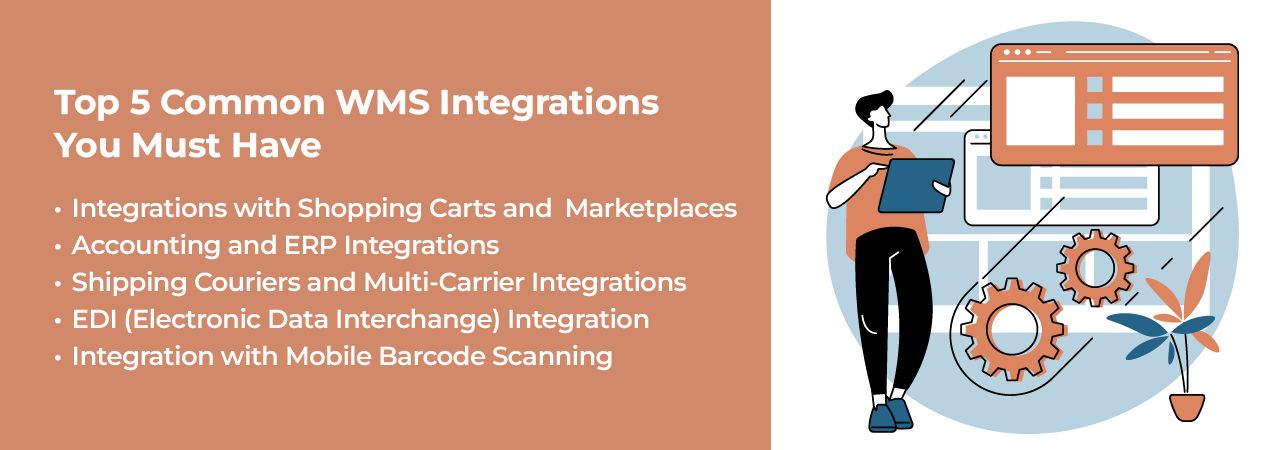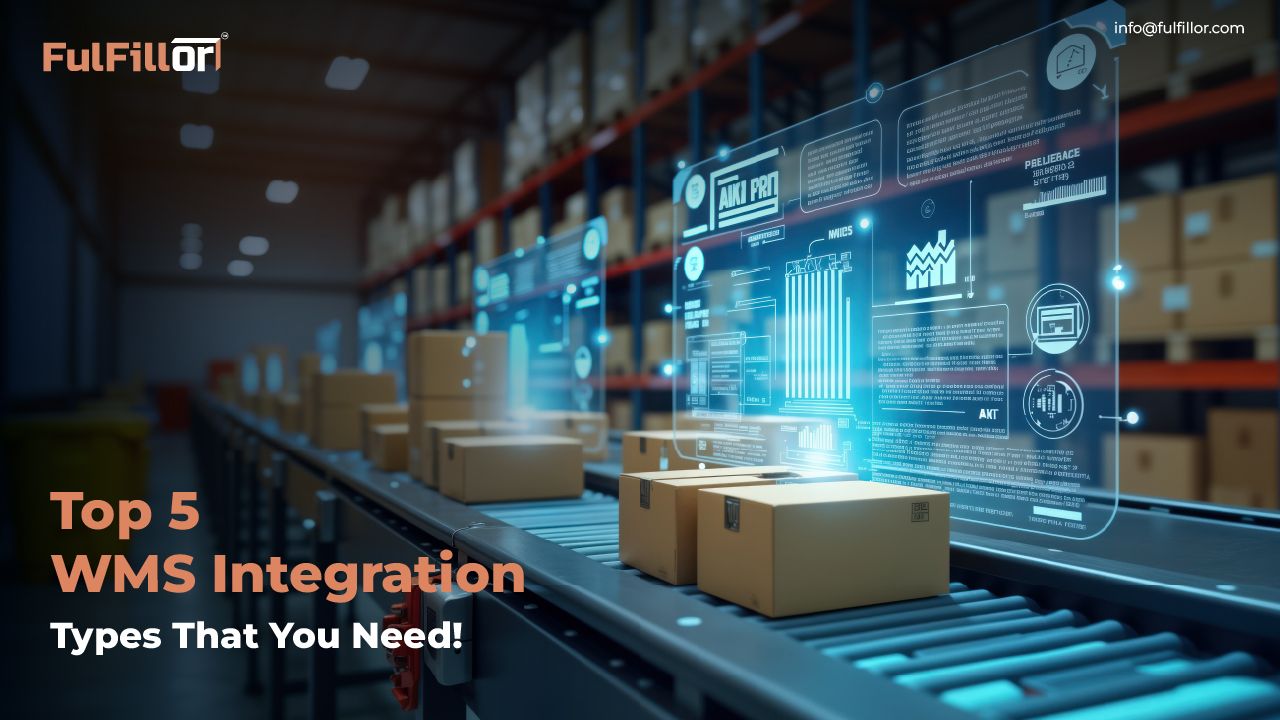Top WMS Integrations for 3PL Warehouses: Types, Benefits & Use Cases
WMS integrations can make or break your warehouse operations. Are your processes operating in silos or synchronized like a clock? Let’s be real: just as an orchestra collapses into noise without a conductor, a warehouse without a connected system falls into chaos. Nothing syncs. Orders get delayed. Inventory gets misplaced. Customers get frustrated.
This is where WMS integrations come into play. Did you know that almost half of warehouse managers identify integration challenges as the top barrier to operational efficiency? A robust and well-integrated warehouse management system (WMS) does not just track inventory; it integrates all your logistics software, allowing real-time data synchronization, system interoperability, and end-to-end fulfillment visibility. So, what are the different kinds of WMS integrations that can change your business game? Let’s continue reading!
What Are WMS Integrations? Definition and Importance
WMS integrations connect your Warehouse Management System to other critical business systems like ERP, Accounting Software, Shopping carts, Marketplaces, etc. Consider WMS integrations as the “bridges” between your warehouse management system and complementary tools in your logistics software stack–such as your e-commerce storefront, shipping software, or ERP (Enterprise Resource Planning). This makes them able to connect or share info via WMS integrations.
Instead of manually copying data or having five different platforms to log into, WMS integrations sync everything in real time, eliminating human error and ensuring your team can work smarter, not harder. Whether you run an e-commerce store or a 3PL operation, WMS integrations facilitate scalable warehouse operations and unified commerce fulfillment. Seamless integration means that processes become more efficient, errors are minimized, and overall efficiency improves.
Let us now discuss the different types of WMS integrations as well as the necessary integrations depending on your business needs.
Why WMS Integrations Matter: Top Benefits for Warehouses & 3PLs

In the cohesive commerce fulfillment world, disparate or disconnected systems cause:
- Late shipments
- Stockouts or overstocks
- Slow response times
- Frustrated customers
Below are some key benefits of different types of WMS integrations:
-
End-to-End Visibility: Prevent stock outs or overselling with real-time tracking of inventory, orders, and shipments across all channels.
-
Enhanced Order Accuracy: Reduce common fulfillment mistakes like overselling or improper shipments, with automated data syncing.
-
Scalable Operations: Manage business growth or seasonal surges with no operational bottlenecks.
-
Cost efficiency: By automating repetitive processes, organizations can save on labor hours and operational expenses, thus improving efficiency.
-
Customer Experience: Faster processing and accurate deliveries translate into good reviews and repeat customers.
-
Inter-system interoperability: This allows smooth communication between different software systems.
Top 5 must-have WMS Integrations to boost warehouse efficiency

1. Integrations with Shopping Carts and Marketplaces
Pain points: Managing orders manually from different e-commerce platforms leads to delays in processing, inventory mismatches, and an increase in the chances of manual errors. Imagine you receive a torrent of orders from Shopify, Amazon Marketplace, or WooCommerce, but your Warehouse Management System has no clue unless somebody types it in on the keyboard and enters the sales order. By the time it’s revised, the product may be oversold or shipped late.
Solution: Integrating your WMS with online marketplaces and shopping carts ensures that orders are imported automatically, inventory is synced, and shipments can be tracked smoothly. This functionality provides real-time visibility and lightning-fast processing while avoiding manual data entry and minimizing fulfillment errors. The result? Quicker shipping, decreased stockouts, and more satisfied customers.
2. Accounting and ERP Integrations
Pain Points: Disconnected systems turn financial reconciliation into a nightmare, leading to delays, stock valuation errors, and poor decision-making based on outdated data. Your warehouse thinks you have one amount of product available, your accounting software thinks you have another, and getting them on the same page takes hours with room for costly errors.
Solution: Connect your WMS to your ERP or accounting system (i.e., QuickBooks, NetSuite, SAP) so that financial data stays in sync with inventory transactions. As shipments go out or there are updates to the inventory, financial records are automatically updated in real time - no manual intervention is needed. It brings a single source of truth across departments, improves the accuracy rate of reporting, and enables leaders to make better data-driven decisions.
3. Shipping Couriers and Multi-Carrier Integrations
Pain Point: Comparing shipping rates across multiple courier systems costs time and efficiency, leading to late deliveries and bloating costs. Picking the right shipping rate manually? It’s slow, error-prone, and usually more expensive than it ought to be.
Solution: A modern WMS should connect directly to couriers, such as FedEx, UPS, USPS, and DHL, via multi-carrier shipping integration. This includes everything from generating labels to shopping for rates and tracking in real time. It allows you to instantly select the cheapest and fastest shipping method for each order, reduce the amount of manual input you have to carry out, and keep customers informed with real-time tracking updates. It’s a game-changer for fulfillment speed and client satisfaction, something that’s especially important for 3PLs when managing disparate customer needs.
4. EDI (Electronic Data Interchange) Integration
Pain Points: EDI compliance is required by many of large retail partners, yet manual data exchanges between systems cause delays, miscommunication, and failed transactions. Are you still processing bulk B2B orders manually? That’s a recipe for mistakes - and big retailers won’t stick around while you figure things out.
Solution: Your warehouse management system (WMS) can be integrated with EDI to automatically receive and process critical documentation such as purchase orders, invoices, and advance shipping notifications. No more spreadsheets or copy and pasting data. A retailer dispatches an order, and your WMS immediately reacts – allocating inventory, marking order status, and starting shipment workflows. This helps not just in meeting standards for compliance by trading partners but also strengthens your reputation for reliability and speed in the B2B arena.
5. Mobile Barcode Scanning Integration in WMS
Pain Points: Manually entering SKUs (Stock Keeping Unit) during warehouse operations leads to picking errors, lost inventory, and decreased productivity. The workers end up wasting time double-checking SKUs and counting without scanning, causing business slow downs and errors.
Solution: Integrating mobile barcode scanning enhances the efficiency of the warehouse. With the ability for employees to scan items during receiving, picking, packing, and shipping, inventory is updated in real time with pinpoint accuracy. This cuts down mis-picks, speeds up order processing and keeps your records matching what’s actually in the shelves.
Maximize Your WMS Integrations with FulFillor WMS
FulFillor WMS integrates with 150+ carts and marketplaces - no more order syncing headaches.
Well, you might be asking: how do you implement these WMS integrations? This is where the need for a robust 3PL WMS cannot be overlooked. FulFillor - our cloud-based advanced 3PL WMS is designed to be user-friendly, so you can manage all your integrations in one place without any hassle. Custom-built for e-commerce, 3PLs, and multi-channel sellers, it raises the bar for WMS integrations through 150+ out-of-the-box, plug-and-play integrations with:
-
Major marketplaces and shopping carts like Shopify, Amazon Marketplace, and WooCommerce.
-
ERP tools (e.g., QuickBooks, NetSuite, or open-source solutions like Moqui Framework and Apache OFBiz.)
-
Shipping carriers: USPS, DHL, FedEx, etc.
-
Barcode Scanning Devices and Mobile Workflows.
-
Seamless Compliance with Retailers Using EDI Connectors - all under a single platform.
And if you want something custom and especially tailored for you?
FulFillor’s WMS integration middleware makes it possible for your logistics software stack to work in harmony to give you unified commerce fulfillment. This extensive integration capacity enables companies to access features such as real-time analytics dashboards, which optimize workflows, along with streamlining the interconnectivity between different systems.
Conclusion: Unlock Efficiency with Smart WMS Integrations
Seamless fulfillment is achieved when your WMS smoothly integrates with your sales channels, finance systems, and logistics stack. Orders flow faster. Customers stay happier. And your business operates like a fine-tuned machine. Understanding the right WMS integration types can help you transform operations, improve efficiency, and accomplish customer satisfaction. We have explored the top 5 WMS integrations and seen the difference it creates for the businesses.
Are you ready to optimize your warehouse operations and get more powerful logistics? So, you want to see FulFillor’s integrations in action? Learn how FulFillor can assist you in extracting the maximum benefit from your WMS integrations and grow your business! Through plug-and-play integrations, real-time data syncing, and streamlined workflows, we make warehouse management smart, simple, and scalable.
Schedule a free demo today and discover how we can help streamline your fulfillment stack and ditch the tech headaches.

